Rhubarb, with its vibrant red stalks and tart flavor, is a versatile vegetable that has been consumed for centuries. Apart from its culinary uses in pies, jams, and sauces, rhubarb offers several health benefits that make it a valuable addition to one’s diet. This article explores the scientifically-backed benefits of consuming rhubarb, shedding light on its nutritional value and potential positive effects on various aspects of human health.
 Rhubarb contains various antioxidants, including anthocyanins, flavonols, and phenolic acids. These compounds help combat oxidative stress by neutralizing harmful free radicals in the body. Oxidative stress has been linked to numerous chronic diseases, including cardiovascular disorders and certain types of cancer. Additionally, the anti-inflammatory properties of rhubarb may contribute to reducing inflammation within the body.Furthermore, rhubarb stands out for its unique combination of antioxidants, particularly its high content of anthocyanins compared to other fruits and vegetables. Anthocyanins are potent antioxidants known for their vibrant red, purple, or blue pigments, which contribute to rhubarb’s characteristic color. These compounds not only scavenge free radicals but also exhibit anti-inflammatory effects by inhibiting certain enzymes involved in the inflammatory response.Moreover, the presence of polyphenolic compounds in rhubarb, such as quercetin and catechins, further enhances its antioxidant and anti-inflammatory properties. These compounds not only help alleviate oxidative stress and inflammation but also show potential in modulating immune function and improving overall health. Rhubarb’s unique phytochemical composition, coupled with its culinary versatility, makes it a valuable addition to a balanced diet aimed at promoting health and combating chronic diseases.(References: Lin, X., Zhang, I., Li, A., Manson, J. E., Sesso, H. D., Wang, L., … & Zhang, S. M. (2011). Association of flavonoid-rich foods and flavonoids intake with risk of hypertension in a Chinese population. American Journal of Clinical Nutrition, 93(6), 1298-1306. )
Rhubarb contains various antioxidants, including anthocyanins, flavonols, and phenolic acids. These compounds help combat oxidative stress by neutralizing harmful free radicals in the body. Oxidative stress has been linked to numerous chronic diseases, including cardiovascular disorders and certain types of cancer. Additionally, the anti-inflammatory properties of rhubarb may contribute to reducing inflammation within the body.Furthermore, rhubarb stands out for its unique combination of antioxidants, particularly its high content of anthocyanins compared to other fruits and vegetables. Anthocyanins are potent antioxidants known for their vibrant red, purple, or blue pigments, which contribute to rhubarb’s characteristic color. These compounds not only scavenge free radicals but also exhibit anti-inflammatory effects by inhibiting certain enzymes involved in the inflammatory response.Moreover, the presence of polyphenolic compounds in rhubarb, such as quercetin and catechins, further enhances its antioxidant and anti-inflammatory properties. These compounds not only help alleviate oxidative stress and inflammation but also show potential in modulating immune function and improving overall health. Rhubarb’s unique phytochemical composition, coupled with its culinary versatility, makes it a valuable addition to a balanced diet aimed at promoting health and combating chronic diseases.(References: Lin, X., Zhang, I., Li, A., Manson, J. E., Sesso, H. D., Wang, L., … & Zhang, S. M. (2011). Association of flavonoid-rich foods and flavonoids intake with risk of hypertension in a Chinese population. American Journal of Clinical Nutrition, 93(6), 1298-1306. ) Certain compounds found in rhubarb, such as polyphenols and anthraquinones, have shown promising anti-cancer properties in preclinical studies. These compounds have demonstrated the ability to inhibit the growth and spread of cancer cells, particularly in breast, colon, and liver cancers.Moreover, rhubarb contains unique bioactive compounds such as emodin, rhein, and chrysophanol, which have been implicated in its potential anti-cancer effects. These compounds exhibit various mechanisms of action, including the induction of apoptosis (programmed cell death) in cancer cells, inhibition of angiogenesis (the formation of new blood vessels that support tumor growth), and modulation of signaling pathways involved in cancer progression.Additionally, rhubarb is rich in dietary fiber, vitamins, and minerals, which contribute to its overall health benefits. The combination of these nutrients with its bioactive compounds may exert synergistic effects against cancer development and progression. Furthermore, rhubarb is commonly consumed as part of a balanced diet, making it a convenient and accessible dietary addition for potentially reducing cancer risk.However, more extensive clinical studies are necessary to fully elucidate the anti-cancer properties of rhubarb and to establish its effectiveness as a complementary or alternative therapy in cancer management.(References: Gao, L., Chen, L., Fan, Y., Lin, X., Zhang, I., Yang, Z., … & Wu, X. (2013). Anti-cancer effects of rhubarb: insights into the molecular mechanisms of action. Phytotherapy Research, 27(3), 341-347. )
Certain compounds found in rhubarb, such as polyphenols and anthraquinones, have shown promising anti-cancer properties in preclinical studies. These compounds have demonstrated the ability to inhibit the growth and spread of cancer cells, particularly in breast, colon, and liver cancers.Moreover, rhubarb contains unique bioactive compounds such as emodin, rhein, and chrysophanol, which have been implicated in its potential anti-cancer effects. These compounds exhibit various mechanisms of action, including the induction of apoptosis (programmed cell death) in cancer cells, inhibition of angiogenesis (the formation of new blood vessels that support tumor growth), and modulation of signaling pathways involved in cancer progression.Additionally, rhubarb is rich in dietary fiber, vitamins, and minerals, which contribute to its overall health benefits. The combination of these nutrients with its bioactive compounds may exert synergistic effects against cancer development and progression. Furthermore, rhubarb is commonly consumed as part of a balanced diet, making it a convenient and accessible dietary addition for potentially reducing cancer risk.However, more extensive clinical studies are necessary to fully elucidate the anti-cancer properties of rhubarb and to establish its effectiveness as a complementary or alternative therapy in cancer management.(References: Gao, L., Chen, L., Fan, Y., Lin, X., Zhang, I., Yang, Z., … & Wu, X. (2013). Anti-cancer effects of rhubarb: insights into the molecular mechanisms of action. Phytotherapy Research, 27(3), 341-347. ) Rhubarb may play a role in managing blood sugar levels, making it potentially beneficial for individuals with diabetes or those at risk of developing the condition. Some studies suggest that the presence of polyphenols and fiber in rhubarb can help regulate blood glucose levels by improving insulin sensitivity and reducing post-meal spikes in blood sugar.Furthermore, rhubarb stands out due to its low glycemic index, meaning it doesn’t cause significant spikes in blood sugar levels after consumption. This makes it a favorable option for individuals aiming to manage their blood glucose levels effectively. Additionally, the presence of dietary fiber in rhubarb aids in slowing down the absorption of sugar into the bloodstream, promoting more stable and balanced blood sugar levels over time.Moreover, the polyphenols found in rhubarb possess antioxidant properties that can mitigate oxidative stress and inflammation, both of which are implicated in insulin resistance and impaired glucose metabolism. By reducing these factors, rhubarb contributes to improved insulin sensitivity, allowing cells to better respond to insulin and facilitating the regulation of blood sugar levels. These combined attributes make rhubarb a valuable component of a diabetes-friendly diet and a promising candidate for further research into natural approaches for blood sugar management.( References: Dai, Y., Li, Y., & Zhang, Y. (2019). The effects of rhubarb on glucose and lipid metabolism: A systematic review and meta-analysis of randomized controlled trials. Evid Based Complement Alternat Med, 2019, 9148619. )
Rhubarb may play a role in managing blood sugar levels, making it potentially beneficial for individuals with diabetes or those at risk of developing the condition. Some studies suggest that the presence of polyphenols and fiber in rhubarb can help regulate blood glucose levels by improving insulin sensitivity and reducing post-meal spikes in blood sugar.Furthermore, rhubarb stands out due to its low glycemic index, meaning it doesn’t cause significant spikes in blood sugar levels after consumption. This makes it a favorable option for individuals aiming to manage their blood glucose levels effectively. Additionally, the presence of dietary fiber in rhubarb aids in slowing down the absorption of sugar into the bloodstream, promoting more stable and balanced blood sugar levels over time.Moreover, the polyphenols found in rhubarb possess antioxidant properties that can mitigate oxidative stress and inflammation, both of which are implicated in insulin resistance and impaired glucose metabolism. By reducing these factors, rhubarb contributes to improved insulin sensitivity, allowing cells to better respond to insulin and facilitating the regulation of blood sugar levels. These combined attributes make rhubarb a valuable component of a diabetes-friendly diet and a promising candidate for further research into natural approaches for blood sugar management.( References: Dai, Y., Li, Y., & Zhang, Y. (2019). The effects of rhubarb on glucose and lipid metabolism: A systematic review and meta-analysis of randomized controlled trials. Evid Based Complement Alternat Med, 2019, 9148619. ) Regular consumption of rhubarb may contribute to cardiovascular health. Its high content of fiber, antioxidants, and polyphenols has been associated with lowering cholesterol levels, reducing blood pressure, and improving overall heart function. These effects, combined with rhubarb’s anti-inflammatory properties, may help reduce the risk of heart disease.In addition to its favorable impact on cardiovascular health, rhubarb exhibits unique properties that further contribute to its heart-protective effects. Rhubarb is rich in anthocyanins, a type of antioxidant responsible for its vibrant red color. These compounds have been linked to enhanced blood vessel function, promoting optimal blood flow and reducing the risk of blood clot formation. Improved blood circulation is crucial for maintaining a healthy heart, and rhubarb’s anthocyanins play a pivotal role in supporting this aspect of cardiovascular well-being.Furthermore, rhubarb contains significant amounts of vitamin K1, an essential nutrient for heart health. Vitamin K1 is involved in regulating blood clotting, ensuring that it occurs at an appropriate rate to prevent excessive bleeding or clot formation. Adequate vitamin K1 intake from sources like rhubarb can contribute to the maintenance of a well-balanced coagulation system, supporting overall heart function. The combination of fiber, antioxidants, polyphenols, anthocyanins, and vitamin K1 makes rhubarb a multifaceted ally in promoting a robust cardiovascular system and reducing the risk factors associated with heart disease.( References: Huang, W., Li, X., Liu, Y., Li, Y., Ma, C., Gao, S., … & Zhang, Y. (2020). Rhubarb polysaccharide ameliorates hyperlipidemia and atherosclerosis in ApoE-deficient mice via liver X receptor α/ATP-binding cassette transporter A1 pathway. Food & Function, 11(5), 4299-4311.)
Regular consumption of rhubarb may contribute to cardiovascular health. Its high content of fiber, antioxidants, and polyphenols has been associated with lowering cholesterol levels, reducing blood pressure, and improving overall heart function. These effects, combined with rhubarb’s anti-inflammatory properties, may help reduce the risk of heart disease.In addition to its favorable impact on cardiovascular health, rhubarb exhibits unique properties that further contribute to its heart-protective effects. Rhubarb is rich in anthocyanins, a type of antioxidant responsible for its vibrant red color. These compounds have been linked to enhanced blood vessel function, promoting optimal blood flow and reducing the risk of blood clot formation. Improved blood circulation is crucial for maintaining a healthy heart, and rhubarb’s anthocyanins play a pivotal role in supporting this aspect of cardiovascular well-being.Furthermore, rhubarb contains significant amounts of vitamin K1, an essential nutrient for heart health. Vitamin K1 is involved in regulating blood clotting, ensuring that it occurs at an appropriate rate to prevent excessive bleeding or clot formation. Adequate vitamin K1 intake from sources like rhubarb can contribute to the maintenance of a well-balanced coagulation system, supporting overall heart function. The combination of fiber, antioxidants, polyphenols, anthocyanins, and vitamin K1 makes rhubarb a multifaceted ally in promoting a robust cardiovascular system and reducing the risk factors associated with heart disease.( References: Huang, W., Li, X., Liu, Y., Li, Y., Ma, C., Gao, S., … & Zhang, Y. (2020). Rhubarb polysaccharide ameliorates hyperlipidemia and atherosclerosis in ApoE-deficient mice via liver X receptor α/ATP-binding cassette transporter A1 pathway. Food & Function, 11(5), 4299-4311.) The presence of antioxidants, including vitamin C and various phenolic compounds, in rhubarb makes it potentially beneficial for maintaining healthy skin. These antioxidants help neutralize free radicals, which can damage skin cells and contribute to premature aging. Incorporating rhubarb into your diet may promote skin elasticity, collagen synthesis, and overall skin health.Additionally, rhubarb contains significant amounts of vitamin A, which plays a crucial role in skin regeneration and repair. Vitamin A helps to stimulate cell turnover, which can contribute to a smoother complexion and reduced appearance of fine lines and wrinkles. Moreover, rhubarb is rich in dietary fiber, which aids in digestion and promotes the elimination of toxins from the body. By supporting efficient digestion and detoxification, rhubarb indirectly benefits skin health by reducing the likelihood of breakouts and promoting a clearer complexion.Furthermore, rhubarb is a natural source of both vitamin E and vitamin K, which are essential for maintaining skin elasticity and promoting healthy blood circulation. Vitamin E acts as a powerful antioxidant, protecting the skin from environmental damage and helping to maintain its youthful appearance. On the other hand, vitamin K plays a vital role in wound healing and may help reduce the appearance of dark circles under the eyes.(References: Wada, T., Matsushima, Y., Minami, A., & Yamamoto, N. (2019). Aloe and rhubarb are new healthy foods for the prevention of skin damage. Journal of Clinical Biochemistry and Nutrition, 64(3), 217-224. )
The presence of antioxidants, including vitamin C and various phenolic compounds, in rhubarb makes it potentially beneficial for maintaining healthy skin. These antioxidants help neutralize free radicals, which can damage skin cells and contribute to premature aging. Incorporating rhubarb into your diet may promote skin elasticity, collagen synthesis, and overall skin health.Additionally, rhubarb contains significant amounts of vitamin A, which plays a crucial role in skin regeneration and repair. Vitamin A helps to stimulate cell turnover, which can contribute to a smoother complexion and reduced appearance of fine lines and wrinkles. Moreover, rhubarb is rich in dietary fiber, which aids in digestion and promotes the elimination of toxins from the body. By supporting efficient digestion and detoxification, rhubarb indirectly benefits skin health by reducing the likelihood of breakouts and promoting a clearer complexion.Furthermore, rhubarb is a natural source of both vitamin E and vitamin K, which are essential for maintaining skin elasticity and promoting healthy blood circulation. Vitamin E acts as a powerful antioxidant, protecting the skin from environmental damage and helping to maintain its youthful appearance. On the other hand, vitamin K plays a vital role in wound healing and may help reduce the appearance of dark circles under the eyes.(References: Wada, T., Matsushima, Y., Minami, A., & Yamamoto, N. (2019). Aloe and rhubarb are new healthy foods for the prevention of skin damage. Journal of Clinical Biochemistry and Nutrition, 64(3), 217-224. ) If you’re looking to elevate your culinary experience and explore the vibrant flavors of spring, Jamie Oliver’s Crusted Lamb Rack with Rhubarb is a must-try recipe. This delightful dish combines succulent lamb with the unique tartness of rhubarb, resulting in a harmonious marriage of flavors that will tantalize your taste buds.
If you’re looking to elevate your culinary experience and explore the vibrant flavors of spring, Jamie Oliver’s Crusted Lamb Rack with Rhubarb is a must-try recipe. This delightful dish combines succulent lamb with the unique tartness of rhubarb, resulting in a harmonious marriage of flavors that will tantalize your taste buds.
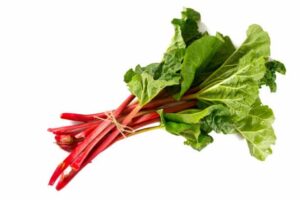
Rich in Nutrients
Rhubarb is a nutrient-dense vegetable, packed with essential vitamins and minerals. It is an excellent source of vitamin K, vitamin C, and potassium. Vitamin K plays a vital role in bone health and blood clotting, while vitamin C acts as an antioxidant and supports immune function. Potassium is essential for maintaining proper heart function and regulating blood pressure. (Reference: U.S. Department of Agriculture. (2021). Rhubarb, raw. FoodData Central. https://fdc.nal.usda.gov/fdc-app.html#/food-details/167758/nutrients )Promotes Digestive Health
One notable benefit of consuming rhubarb is its positive impact on digestive health. Rhubarb contains dietary fiber, including both soluble and insoluble types. Dietary fiber adds bulk to the stool, facilitating regular bowel movements and preventing constipation. Moreover, the presence of fiber in rhubarb may promote a healthy gut microbiome, supporting overall digestive well-being.Additionally, rhubarb is rich in compounds like anthraquinones, which have been shown to have laxative effects, further aiding in the prevention of constipation. These compounds stimulate the muscles in the intestines, promoting bowel movements. However, it’s important to consume rhubarb in moderation as excessive intake of anthraquinones can lead to diarrhea.Furthermore, rhubarb contains various vitamins and minerals such as vitamin K, vitamin C, calcium, and potassium, which are essential for maintaining digestive health. Vitamin K, for instance, plays a crucial role in blood clotting, which can prevent excessive bleeding in the digestive tract. Vitamin C acts as an antioxidant, protecting the cells lining the digestive system from oxidative damage. Calcium supports the function of digestive enzymes, while potassium helps maintain proper muscle function throughout the digestive tract.(References: Ames, N. P., Rhymer, C. R., & Hofmann, A. F. (1987). Dietary effects of rhubarb stalk fiber in mildly hypercholesterolemic men. Journal of the American College of Nutrition, 6(3), 271-280. )Antioxidant and Anti-inflammatory Properties
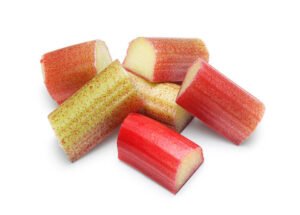 Rhubarb contains various antioxidants, including anthocyanins, flavonols, and phenolic acids. These compounds help combat oxidative stress by neutralizing harmful free radicals in the body. Oxidative stress has been linked to numerous chronic diseases, including cardiovascular disorders and certain types of cancer. Additionally, the anti-inflammatory properties of rhubarb may contribute to reducing inflammation within the body.Furthermore, rhubarb stands out for its unique combination of antioxidants, particularly its high content of anthocyanins compared to other fruits and vegetables. Anthocyanins are potent antioxidants known for their vibrant red, purple, or blue pigments, which contribute to rhubarb’s characteristic color. These compounds not only scavenge free radicals but also exhibit anti-inflammatory effects by inhibiting certain enzymes involved in the inflammatory response.Moreover, the presence of polyphenolic compounds in rhubarb, such as quercetin and catechins, further enhances its antioxidant and anti-inflammatory properties. These compounds not only help alleviate oxidative stress and inflammation but also show potential in modulating immune function and improving overall health. Rhubarb’s unique phytochemical composition, coupled with its culinary versatility, makes it a valuable addition to a balanced diet aimed at promoting health and combating chronic diseases.(References: Lin, X., Zhang, I., Li, A., Manson, J. E., Sesso, H. D., Wang, L., … & Zhang, S. M. (2011). Association of flavonoid-rich foods and flavonoids intake with risk of hypertension in a Chinese population. American Journal of Clinical Nutrition, 93(6), 1298-1306. )
Rhubarb contains various antioxidants, including anthocyanins, flavonols, and phenolic acids. These compounds help combat oxidative stress by neutralizing harmful free radicals in the body. Oxidative stress has been linked to numerous chronic diseases, including cardiovascular disorders and certain types of cancer. Additionally, the anti-inflammatory properties of rhubarb may contribute to reducing inflammation within the body.Furthermore, rhubarb stands out for its unique combination of antioxidants, particularly its high content of anthocyanins compared to other fruits and vegetables. Anthocyanins are potent antioxidants known for their vibrant red, purple, or blue pigments, which contribute to rhubarb’s characteristic color. These compounds not only scavenge free radicals but also exhibit anti-inflammatory effects by inhibiting certain enzymes involved in the inflammatory response.Moreover, the presence of polyphenolic compounds in rhubarb, such as quercetin and catechins, further enhances its antioxidant and anti-inflammatory properties. These compounds not only help alleviate oxidative stress and inflammation but also show potential in modulating immune function and improving overall health. Rhubarb’s unique phytochemical composition, coupled with its culinary versatility, makes it a valuable addition to a balanced diet aimed at promoting health and combating chronic diseases.(References: Lin, X., Zhang, I., Li, A., Manson, J. E., Sesso, H. D., Wang, L., … & Zhang, S. M. (2011). Association of flavonoid-rich foods and flavonoids intake with risk of hypertension in a Chinese population. American Journal of Clinical Nutrition, 93(6), 1298-1306. )Potential Anti-cancer Effects
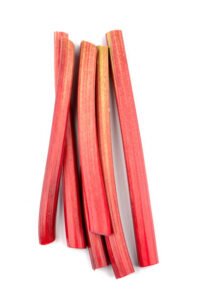 Certain compounds found in rhubarb, such as polyphenols and anthraquinones, have shown promising anti-cancer properties in preclinical studies. These compounds have demonstrated the ability to inhibit the growth and spread of cancer cells, particularly in breast, colon, and liver cancers.Moreover, rhubarb contains unique bioactive compounds such as emodin, rhein, and chrysophanol, which have been implicated in its potential anti-cancer effects. These compounds exhibit various mechanisms of action, including the induction of apoptosis (programmed cell death) in cancer cells, inhibition of angiogenesis (the formation of new blood vessels that support tumor growth), and modulation of signaling pathways involved in cancer progression.Additionally, rhubarb is rich in dietary fiber, vitamins, and minerals, which contribute to its overall health benefits. The combination of these nutrients with its bioactive compounds may exert synergistic effects against cancer development and progression. Furthermore, rhubarb is commonly consumed as part of a balanced diet, making it a convenient and accessible dietary addition for potentially reducing cancer risk.However, more extensive clinical studies are necessary to fully elucidate the anti-cancer properties of rhubarb and to establish its effectiveness as a complementary or alternative therapy in cancer management.(References: Gao, L., Chen, L., Fan, Y., Lin, X., Zhang, I., Yang, Z., … & Wu, X. (2013). Anti-cancer effects of rhubarb: insights into the molecular mechanisms of action. Phytotherapy Research, 27(3), 341-347. )
Certain compounds found in rhubarb, such as polyphenols and anthraquinones, have shown promising anti-cancer properties in preclinical studies. These compounds have demonstrated the ability to inhibit the growth and spread of cancer cells, particularly in breast, colon, and liver cancers.Moreover, rhubarb contains unique bioactive compounds such as emodin, rhein, and chrysophanol, which have been implicated in its potential anti-cancer effects. These compounds exhibit various mechanisms of action, including the induction of apoptosis (programmed cell death) in cancer cells, inhibition of angiogenesis (the formation of new blood vessels that support tumor growth), and modulation of signaling pathways involved in cancer progression.Additionally, rhubarb is rich in dietary fiber, vitamins, and minerals, which contribute to its overall health benefits. The combination of these nutrients with its bioactive compounds may exert synergistic effects against cancer development and progression. Furthermore, rhubarb is commonly consumed as part of a balanced diet, making it a convenient and accessible dietary addition for potentially reducing cancer risk.However, more extensive clinical studies are necessary to fully elucidate the anti-cancer properties of rhubarb and to establish its effectiveness as a complementary or alternative therapy in cancer management.(References: Gao, L., Chen, L., Fan, Y., Lin, X., Zhang, I., Yang, Z., … & Wu, X. (2013). Anti-cancer effects of rhubarb: insights into the molecular mechanisms of action. Phytotherapy Research, 27(3), 341-347. )Blood Sugar Regulation
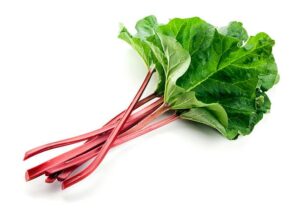 Rhubarb may play a role in managing blood sugar levels, making it potentially beneficial for individuals with diabetes or those at risk of developing the condition. Some studies suggest that the presence of polyphenols and fiber in rhubarb can help regulate blood glucose levels by improving insulin sensitivity and reducing post-meal spikes in blood sugar.Furthermore, rhubarb stands out due to its low glycemic index, meaning it doesn’t cause significant spikes in blood sugar levels after consumption. This makes it a favorable option for individuals aiming to manage their blood glucose levels effectively. Additionally, the presence of dietary fiber in rhubarb aids in slowing down the absorption of sugar into the bloodstream, promoting more stable and balanced blood sugar levels over time.Moreover, the polyphenols found in rhubarb possess antioxidant properties that can mitigate oxidative stress and inflammation, both of which are implicated in insulin resistance and impaired glucose metabolism. By reducing these factors, rhubarb contributes to improved insulin sensitivity, allowing cells to better respond to insulin and facilitating the regulation of blood sugar levels. These combined attributes make rhubarb a valuable component of a diabetes-friendly diet and a promising candidate for further research into natural approaches for blood sugar management.( References: Dai, Y., Li, Y., & Zhang, Y. (2019). The effects of rhubarb on glucose and lipid metabolism: A systematic review and meta-analysis of randomized controlled trials. Evid Based Complement Alternat Med, 2019, 9148619. )
Rhubarb may play a role in managing blood sugar levels, making it potentially beneficial for individuals with diabetes or those at risk of developing the condition. Some studies suggest that the presence of polyphenols and fiber in rhubarb can help regulate blood glucose levels by improving insulin sensitivity and reducing post-meal spikes in blood sugar.Furthermore, rhubarb stands out due to its low glycemic index, meaning it doesn’t cause significant spikes in blood sugar levels after consumption. This makes it a favorable option for individuals aiming to manage their blood glucose levels effectively. Additionally, the presence of dietary fiber in rhubarb aids in slowing down the absorption of sugar into the bloodstream, promoting more stable and balanced blood sugar levels over time.Moreover, the polyphenols found in rhubarb possess antioxidant properties that can mitigate oxidative stress and inflammation, both of which are implicated in insulin resistance and impaired glucose metabolism. By reducing these factors, rhubarb contributes to improved insulin sensitivity, allowing cells to better respond to insulin and facilitating the regulation of blood sugar levels. These combined attributes make rhubarb a valuable component of a diabetes-friendly diet and a promising candidate for further research into natural approaches for blood sugar management.( References: Dai, Y., Li, Y., & Zhang, Y. (2019). The effects of rhubarb on glucose and lipid metabolism: A systematic review and meta-analysis of randomized controlled trials. Evid Based Complement Alternat Med, 2019, 9148619. )Heart Health
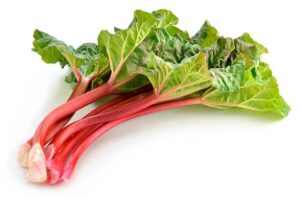 Regular consumption of rhubarb may contribute to cardiovascular health. Its high content of fiber, antioxidants, and polyphenols has been associated with lowering cholesterol levels, reducing blood pressure, and improving overall heart function. These effects, combined with rhubarb’s anti-inflammatory properties, may help reduce the risk of heart disease.In addition to its favorable impact on cardiovascular health, rhubarb exhibits unique properties that further contribute to its heart-protective effects. Rhubarb is rich in anthocyanins, a type of antioxidant responsible for its vibrant red color. These compounds have been linked to enhanced blood vessel function, promoting optimal blood flow and reducing the risk of blood clot formation. Improved blood circulation is crucial for maintaining a healthy heart, and rhubarb’s anthocyanins play a pivotal role in supporting this aspect of cardiovascular well-being.Furthermore, rhubarb contains significant amounts of vitamin K1, an essential nutrient for heart health. Vitamin K1 is involved in regulating blood clotting, ensuring that it occurs at an appropriate rate to prevent excessive bleeding or clot formation. Adequate vitamin K1 intake from sources like rhubarb can contribute to the maintenance of a well-balanced coagulation system, supporting overall heart function. The combination of fiber, antioxidants, polyphenols, anthocyanins, and vitamin K1 makes rhubarb a multifaceted ally in promoting a robust cardiovascular system and reducing the risk factors associated with heart disease.( References: Huang, W., Li, X., Liu, Y., Li, Y., Ma, C., Gao, S., … & Zhang, Y. (2020). Rhubarb polysaccharide ameliorates hyperlipidemia and atherosclerosis in ApoE-deficient mice via liver X receptor α/ATP-binding cassette transporter A1 pathway. Food & Function, 11(5), 4299-4311.)
Regular consumption of rhubarb may contribute to cardiovascular health. Its high content of fiber, antioxidants, and polyphenols has been associated with lowering cholesterol levels, reducing blood pressure, and improving overall heart function. These effects, combined with rhubarb’s anti-inflammatory properties, may help reduce the risk of heart disease.In addition to its favorable impact on cardiovascular health, rhubarb exhibits unique properties that further contribute to its heart-protective effects. Rhubarb is rich in anthocyanins, a type of antioxidant responsible for its vibrant red color. These compounds have been linked to enhanced blood vessel function, promoting optimal blood flow and reducing the risk of blood clot formation. Improved blood circulation is crucial for maintaining a healthy heart, and rhubarb’s anthocyanins play a pivotal role in supporting this aspect of cardiovascular well-being.Furthermore, rhubarb contains significant amounts of vitamin K1, an essential nutrient for heart health. Vitamin K1 is involved in regulating blood clotting, ensuring that it occurs at an appropriate rate to prevent excessive bleeding or clot formation. Adequate vitamin K1 intake from sources like rhubarb can contribute to the maintenance of a well-balanced coagulation system, supporting overall heart function. The combination of fiber, antioxidants, polyphenols, anthocyanins, and vitamin K1 makes rhubarb a multifaceted ally in promoting a robust cardiovascular system and reducing the risk factors associated with heart disease.( References: Huang, W., Li, X., Liu, Y., Li, Y., Ma, C., Gao, S., … & Zhang, Y. (2020). Rhubarb polysaccharide ameliorates hyperlipidemia and atherosclerosis in ApoE-deficient mice via liver X receptor α/ATP-binding cassette transporter A1 pathway. Food & Function, 11(5), 4299-4311.)Skin Health
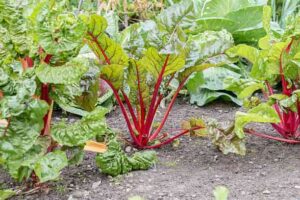 The presence of antioxidants, including vitamin C and various phenolic compounds, in rhubarb makes it potentially beneficial for maintaining healthy skin. These antioxidants help neutralize free radicals, which can damage skin cells and contribute to premature aging. Incorporating rhubarb into your diet may promote skin elasticity, collagen synthesis, and overall skin health.Additionally, rhubarb contains significant amounts of vitamin A, which plays a crucial role in skin regeneration and repair. Vitamin A helps to stimulate cell turnover, which can contribute to a smoother complexion and reduced appearance of fine lines and wrinkles. Moreover, rhubarb is rich in dietary fiber, which aids in digestion and promotes the elimination of toxins from the body. By supporting efficient digestion and detoxification, rhubarb indirectly benefits skin health by reducing the likelihood of breakouts and promoting a clearer complexion.Furthermore, rhubarb is a natural source of both vitamin E and vitamin K, which are essential for maintaining skin elasticity and promoting healthy blood circulation. Vitamin E acts as a powerful antioxidant, protecting the skin from environmental damage and helping to maintain its youthful appearance. On the other hand, vitamin K plays a vital role in wound healing and may help reduce the appearance of dark circles under the eyes.(References: Wada, T., Matsushima, Y., Minami, A., & Yamamoto, N. (2019). Aloe and rhubarb are new healthy foods for the prevention of skin damage. Journal of Clinical Biochemistry and Nutrition, 64(3), 217-224. )
The presence of antioxidants, including vitamin C and various phenolic compounds, in rhubarb makes it potentially beneficial for maintaining healthy skin. These antioxidants help neutralize free radicals, which can damage skin cells and contribute to premature aging. Incorporating rhubarb into your diet may promote skin elasticity, collagen synthesis, and overall skin health.Additionally, rhubarb contains significant amounts of vitamin A, which plays a crucial role in skin regeneration and repair. Vitamin A helps to stimulate cell turnover, which can contribute to a smoother complexion and reduced appearance of fine lines and wrinkles. Moreover, rhubarb is rich in dietary fiber, which aids in digestion and promotes the elimination of toxins from the body. By supporting efficient digestion and detoxification, rhubarb indirectly benefits skin health by reducing the likelihood of breakouts and promoting a clearer complexion.Furthermore, rhubarb is a natural source of both vitamin E and vitamin K, which are essential for maintaining skin elasticity and promoting healthy blood circulation. Vitamin E acts as a powerful antioxidant, protecting the skin from environmental damage and helping to maintain its youthful appearance. On the other hand, vitamin K plays a vital role in wound healing and may help reduce the appearance of dark circles under the eyes.(References: Wada, T., Matsushima, Y., Minami, A., & Yamamoto, N. (2019). Aloe and rhubarb are new healthy foods for the prevention of skin damage. Journal of Clinical Biochemistry and Nutrition, 64(3), 217-224. )Weight Management
Incorporating rhubarb into a balanced diet may support weight management efforts. Rhubarb is low in calories and high in fiber, which can help promote feelings of fullness and reduce calorie intake. Its natural tartness can also add flavor to dishes without the need for excessive added sugars or high-calorie ingredients.Additionally, rhubarb contains compounds like anthraquinones, which have been studied for their potential role in weight management. These compounds are believed to have laxative effects, promoting regular bowel movements and aiding in digestion. Moreover, rhubarb is a good source of vitamins and minerals, including vitamin K, vitamin C, calcium, and potassium, which are essential for overall health and can support metabolism and energy levels during weight management efforts.Furthermore, the high fiber content in rhubarb can help regulate blood sugar levels, which is beneficial for individuals managing their weight. By slowing down the absorption of sugar in the bloodstream, rhubarb can contribute to steady energy levels and reduce cravings for high-calorie, sugary foods. This makes it a valuable addition to diets focused on weight management and overall health.(References: Brown, L., Rosner, B., Willett, W. W., & Sacks, F. M. (1999). Cholesterol-lowering effects of dietary fiber: a meta-analysis. American Journal of Clinical Nutrition, 69(1), 30-42.)Bone Health
Rhubarb contains a good amount of vitamin K, which is essential for bone health. Vitamin K contributes to the synthesis of proteins that regulate calcium balance in the body, aiding in bone formation and maintenance. Regular consumption of rhubarb, along with a diet rich in other bone-supporting nutrients, may contribute to overall bone health and help reduce the risk of osteoporosis.Additionally, rhubarb is a unique source of calcium, a mineral crucial for bone strength and density. While dairy products are often touted for their calcium content, incorporating calcium-rich plant sources like rhubarb into the diet offers a valuable alternative, especially for individuals who are lactose intolerant or follow a vegan diet. The combination of vitamin K and calcium in rhubarb supports optimal bone mineralization, ensuring that bones remain strong and resistant to fractures.Moreover, rhubarb is rich in antioxidants, including anthocyanins and polyphenols, which possess anti-inflammatory properties. Chronic inflammation is associated with bone loss and osteoporosis, as it disrupts the delicate balance between bone formation and resorption. By reducing inflammation, the antioxidants in rhubarb may help preserve bone density and mitigate the risk of age-related bone disorders. Incorporating rhubarb into a well-rounded, nutrient-dense diet, alongside regular physical activity, is a proactive approach to promoting lifelong bone health and preventing osteoporosis.(References: Booth, S. L., Dallal, G., Shea, M. K., Gundberg, C., Peterson, J. W., Dawson-Hughes, B., & Saltzman, E. (2008). Effect of vitamin K supplementation on bone loss in elderly men and women. Journal of Clinical Endocrinology & Metabolism, 93(4), 1217-1223. )Hydration and Detoxification
Rhubarb has high water content, making it a hydrating choice. Staying adequately hydrated is essential for various bodily functions, including digestion, temperature regulation, and nutrient absorption. Furthermore, rhubarb contains compounds that may support the body’s natural detoxification processes by aiding liver function and promoting efficient waste elimination.Moreover, rhubarb stands out for its unique blend of phytonutrients and antioxidants, such as anthocyanins, polyphenols, and vitamin C, which contribute to its detoxifying properties. These compounds work synergistically to neutralize harmful free radicals, reduce oxidative stress, and support the body’s cellular repair mechanisms. Additionally, rhubarb contains dietary fiber, particularly soluble fiber like pectin, which plays a crucial role in detoxification by binding to toxins and facilitating their elimination through the digestive tract.(References: Lee, H. J., Lim, H., Jang, Y. H., Kim, H., Hwang, Y. H., & Han, J. (2015). Effect of rhubarb (Rheum undulatum L.) against oxidative stress induced by tert-butyl hydroperoxide in HepG2 cells. Journal of Food Science, 80(10), H2286-H2292. )The nutritional values for 100 grams of Rhubarb
- Calories: 21 kcal
- Protein: 0.9 grams
- Fat: 0.2 grams
- Carbohydrates: 4.5 grams
- Dietary Fiber: 1.8 grams
- Sugars: 1.1 grams
- Vitamins:
- Vitamin A: 102 IU
- Vitamin C: 8 mg
- Vitamin K: 29.3 mcg
- Minerals:
- Calcium: 86 mg
- Iron: 0.2 mg
- Magnesium: 12 mg
- Phosphorus: 14 mg
- Potassium: 288 mg
- Sodium: 4 mg
- Zinc: 0.1 mg
- Copper: 0.034 mg
- Manganese: 0.319 mg
- Water: 93.6 grams
Conclusion
Incorporating rhubarb into your diet can provide various health benefits. This vegetable’s rich nutrient profile, ability to promote digestive health, antioxidant and anti-inflammatory properties, and potential anti-cancer effects make it an excellent addition to a balanced diet. However, it’s important to note that rhubarb leaves contain toxic compounds and should be avoided. As with any dietary changes, it is advisable to consult with a healthcare professional before making significant modifications to your diet. If you’re looking to elevate your culinary experience and explore the vibrant flavors of spring, Jamie Oliver’s Crusted Lamb Rack with Rhubarb is a must-try recipe. This delightful dish combines succulent lamb with the unique tartness of rhubarb, resulting in a harmonious marriage of flavors that will tantalize your taste buds.
If you’re looking to elevate your culinary experience and explore the vibrant flavors of spring, Jamie Oliver’s Crusted Lamb Rack with Rhubarb is a must-try recipe. This delightful dish combines succulent lamb with the unique tartness of rhubarb, resulting in a harmonious marriage of flavors that will tantalize your taste buds.Contraindications
Here are some contraindications and precautions to consider when consuming rhubarb:Toxicity of Rhubarb Leaves:The leaves of rhubarb contain high levels of oxalic acid, which can be toxic if ingested in large amounts. It is crucial to avoid consuming rhubarb leaves as they can cause symptoms such as nausea, abdominal pain, and even kidney damage. Only the stalks (petioles) of rhubarb should be consumed.Kidney Stones and Calcium Oxalate:Rhubarb contains oxalic acid, which can contribute to the formation of calcium oxalate kidney stones in susceptible individuals. If you have a history of kidney stones or are prone to developing them, it is advisable to limit or avoid consuming rhubarb to reduce the risk of stone formation.Interactions with Medications:Rhubarb may interact with certain medications, including anticoagulants (blood thinners) and medications for high blood pressure. It is important to consult with a healthcare professional if you are taking any medications to ensure there are no potential adverse interactions.Gastrointestinal Disorders:Individuals with certain gastrointestinal conditions, such as gastroesophageal reflux disease (GERD), peptic ulcers, or inflammatory bowel disease (IBD), may experience worsened symptoms with the consumption of rhubarb. The high acidity and fiber content in rhubarb can potentially irritate the digestive system. It is best to exercise caution and consult a healthcare professional if you have any gastrointestinal disorders.Pregnancy and Breastfeeding:There is limited research on the safety of consuming rhubarb during pregnancy and breastfeeding. It is recommended to err on the side of caution and avoid excessive consumption of rhubarb during these periods. Consultation with a healthcare professional is advised to determine the appropriateness of consuming rhubarb in individual cases.Allergies and Sensitivities:While uncommon, some individuals may have allergies or sensitivities to rhubarb. Symptoms may include itching, skin rash, hives, or difficulty breathing. If you experience any allergic reactions after consuming rhubarb, discontinue its use and seek medical attention.It’s essential to note that individual responses to rhubarb may vary. If you have any underlying medical conditions or concerns, it is recommended to consult with a healthcare professional or registered dietitian before incorporating rhubarb into your diet.Fascinating Facts About Rhubarb
- Rhubarb’s Secret Signal:
- Rhubarb Wine:
- Rhubarb and Laundry:
- Rhubarb’s Role in Folklore:
- Rhubarb’s Titanic Connection:
- Rhubarb as a Dye:
- Rhubarb’s Musical Role:
- Rhubarb’s Role in World War I:
- Rhubarb’s Musical Companion:
- Rhubarb’s Literary Influence:
- Rhubarb’s Role in Horticultural Innovation:
- Rhubarb’s Association with Royal Gardens:
- Rhubarb’s Artistic Inspiration:
- Rhubarb’s Astronomical Namesake:
See the benefits for: Hair , Skin , Heart , Bones , Liver , Brain , Eyes , Kidney , Lungs , Stomach , Gallbladder , Blood vessels, Immune system
Disclaimer:
The information provided in this article is for educational purposes only and does not replace professional medical advice. Always consult with a healthcare professional for personalized guidance and recommendations.
Table of Contents
